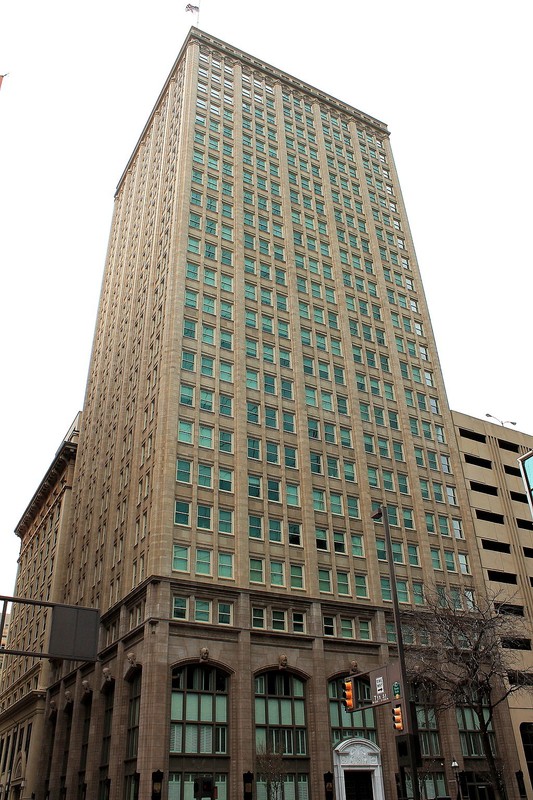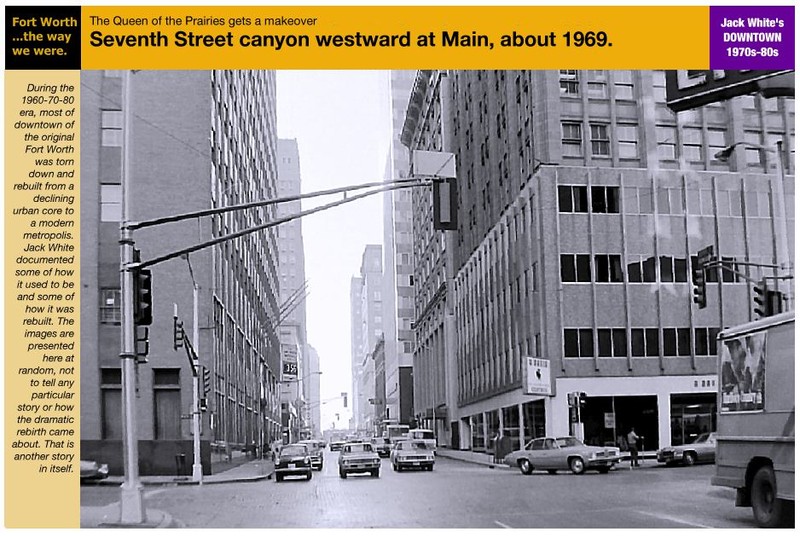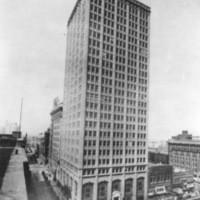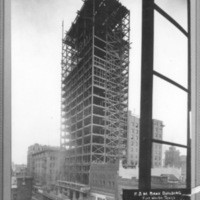714 Main
Introduction
Text-to-speech Audio
Formerly known as, the "Transport Life Building," the "Continental Life Building," the "Fort Worth National Bank Building," and the "Farmers and Mechanics National Bank Building," 714 Main Street is a historic skyscraper located in downtown Fort Worth, Texas. 714 Main was, for a short time, the tallest building in Texas. A visit to 714 Main is a glimpse of Texas history and an architectural treat.
Images
714 Main was built in 1921.

714 Main with 1960s base.

714 Main circa 1920s.

714 Main under construction.

Backstory and Context
Text-to-speech Audio
Though it has had many names, 714 Main is a definitive piece of Fort Worth history.
Rising to a towering 24 stories, 714 main was designed by Sanguinet & Staats and constructed from 1920-1921.1 Initial Construction was done by Mauran, Russell, and Crowell as Associate Architects and with Westlake Construction Company as the General Contractor.2 The building was originally commissioned on behalf of the Farmers and Mechanics National Bank--then a titan of Texas Banking. The building was, for a short time, the tallest building in Texas.3
Aside from being the tallest, the building was also one of the most handsome structures in any skyline, especially in Texas. 714 Main features remarkable four-story arched windows on its base, and arched windows on its 24th floor. These beautiful features grace the building's facade, allowing an unprecedented amount of natural light to filter into the building's lobby and working environments.
Despite its towering height and unique architecture, the building has undergone many renovations since its construction in the early 20th Century. Despite being billed during and after construction as the "Farmers and Mechanics National Bank," 714 Main later became the "Fort Worth National Bank."4 In 1950, the building was sold to the Continental Life Insurance Company and was so named. Shortly after, the Continental Life Insurance Company installed a large red neon sign along the roof, facing the south and east sides of the building.5 These signs were removed during the early 1980s.6 In 1952, the Bank moved. The building's beautiful terra cotta and granite base were covered with blue Mexican tile, and a curtain wall fashioned out of glass.
This renovation was accompanied by new tenants--among them Conoco, who erected a large revolving sign with their logo on the roof. 7 This was removed during the 1970s. In 1988, the "Continental Life Building" was purchased by Transport Life, who renamed the building after themselves. Their occupation was accompanied by a large-scale renovation that re-designed the base of the building in an attempt to restore the former grandeur of the terra cotta. Transport Life vacated the building in 1997. Following their exit, the building fell vacant once again.
714 Main sat vacant for several years following the exit of Transport Life. In 2004, a local Fort Worth developer attempted to renovate the building--first as luxury lofts, then as offices--before XTO Energy bought the building in 2007. XTO continued the renovations and restored the original terra-cotta base at considerable expense. The Fort Worth architecture firm of Schwarz-Hanson Architects was responsible for the renovation.9
Rising to a towering 24 stories, 714 main was designed by Sanguinet & Staats and constructed from 1920-1921.1 Initial Construction was done by Mauran, Russell, and Crowell as Associate Architects and with Westlake Construction Company as the General Contractor.2 The building was originally commissioned on behalf of the Farmers and Mechanics National Bank--then a titan of Texas Banking. The building was, for a short time, the tallest building in Texas.3
Aside from being the tallest, the building was also one of the most handsome structures in any skyline, especially in Texas. 714 Main features remarkable four-story arched windows on its base, and arched windows on its 24th floor. These beautiful features grace the building's facade, allowing an unprecedented amount of natural light to filter into the building's lobby and working environments.
Despite its towering height and unique architecture, the building has undergone many renovations since its construction in the early 20th Century. Despite being billed during and after construction as the "Farmers and Mechanics National Bank," 714 Main later became the "Fort Worth National Bank."4 In 1950, the building was sold to the Continental Life Insurance Company and was so named. Shortly after, the Continental Life Insurance Company installed a large red neon sign along the roof, facing the south and east sides of the building.5 These signs were removed during the early 1980s.6 In 1952, the Bank moved. The building's beautiful terra cotta and granite base were covered with blue Mexican tile, and a curtain wall fashioned out of glass.
This renovation was accompanied by new tenants--among them Conoco, who erected a large revolving sign with their logo on the roof. 7 This was removed during the 1970s. In 1988, the "Continental Life Building" was purchased by Transport Life, who renamed the building after themselves. Their occupation was accompanied by a large-scale renovation that re-designed the base of the building in an attempt to restore the former grandeur of the terra cotta. Transport Life vacated the building in 1997. Following their exit, the building fell vacant once again.
714 Main sat vacant for several years following the exit of Transport Life. In 2004, a local Fort Worth developer attempted to renovate the building--first as luxury lofts, then as offices--before XTO Energy bought the building in 2007. XTO continued the renovations and restored the original terra-cotta base at considerable expense. The Fort Worth architecture firm of Schwarz-Hanson Architects was responsible for the renovation.9
Cite This Entry
Kunkel, Declan and Ben M.. "714 Main." Clio: Your Guide to History. July 22, 2019. Accessed April 16, 2025. https://theclio.com/tour/856/9
Sources
1. Roberts, John, AIA. " 714 Main." Architecture in Fort Worth. 2015. Accessed August 06, 2016. http://www.fortwortharchitecture.com/transprt.htm.
2. Ibid.
3. "714 Main." 714 Main. 2009. Accessed August 06, 2016. http://wikimapia.org/1874455/714-Main.
4. Ibid.
5. Roberts, John, AIA. " 714 Main." Architecture in Fort Worth. 2015. Accessed August 06, 2016. http://www.fortwortharchitecture.com/transprt.htm.
6. Ibid.
7. "714 Main." 714 Main. 2009. Accessed August 06, 2016. http://wikimapia.org/1874455/714-Main.
8. Roberts, John, AIA. " 714 Main." Architecture in Fort Worth. 2015. Accessed August 06, 2016. http://www.fortwortharchitecture.com/transprt.htm.
9. Ibid.
2. Ibid.
3. "714 Main." 714 Main. 2009. Accessed August 06, 2016. http://wikimapia.org/1874455/714-Main.
4. Ibid.
5. Roberts, John, AIA. " 714 Main." Architecture in Fort Worth. 2015. Accessed August 06, 2016. http://www.fortwortharchitecture.com/transprt.htm.
6. Ibid.
7. "714 Main." 714 Main. 2009. Accessed August 06, 2016. http://wikimapia.org/1874455/714-Main.
8. Roberts, John, AIA. " 714 Main." Architecture in Fort Worth. 2015. Accessed August 06, 2016. http://www.fortwortharchitecture.com/transprt.htm.
9. Ibid.

